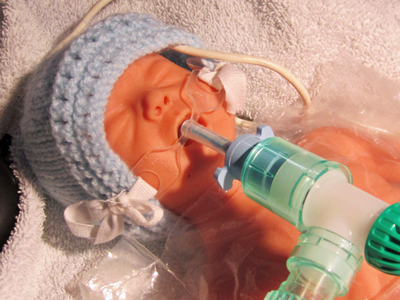
John Crowe and colleagues describe the process of developing a pulse monitor for newborn babies.
Instruments for monitoring physiological functions such as heart and breathing rates, temperature and blood pressure are now widely and cheaply available. Consequently, it is rare that the opportunity arises to consider the ergonomics of a new physiological monitor. However, this opportunity did arise in a collaborative project between the Faculty of Engineering and the Department of Child Health at the University of Nottingham.
The team are developing an optical based sensor, named HeartLight, that can record the cardiac synchronous variations in blood volume, that is, the pulse, from which heart rate can be calculated.
The monitor is to be used during the resuscitation of newborn infants, necessary in 10% of births. The aim is to remove the need for practitioners to suspend the resuscitation process in order to manually measure the baby’s heart rate by counting the beats whilst listening with a stethoscope. It also aims to reduce the risk of errors that are known to occur during manual counting.
The capture of user requirements in this project was essential to the development of the instrumentation. Therefore, the collaboration of human factors academics, clinical consultants and research nurses was vital to the iterative process around which the heart monitor was developed.
The ergonomic requirements of this sensor are twofold. First, the design of the sensor and its attachment mechanism and second, how the calculated heart rate is relayed to the practitioner. Sensor placement must fit within clinical practice that involves placing the premature baby in a polythene wrap/bag and putting a hat on them to avoid hypothermia.
The sensor requires contact with the surface of the skin on an area where it is thin enough for the fluctuations in blood volume to be measured. Studies demonstrated that the sensor placement on the forehead obtained reliable results within these parameters. This fact presented a viable solution for attachment of the device. By placing the sensor under the hat against the forehead it presented an optimal position for monitoring. Another benefit of this placement was that the sensor would be unlikely to be dislodged during the resuscitation process.
The scale of technology for use with neonates is another significant consideration. Engineers working on this project have had to consider the specialist requirements and critical time pressures of a resuscitation environment; multiple sensors and alarms, medical devices and hardware with wiring, in addition the need for practitioners to carry out the resuscitation process on a small baby. Technology requirements therefore have to be developed for both the adult clinical user and the tiny patient.
The display of heart rate measures raises more questions. Should the output be visual or audible? What format should this take? Do less experienced clinical staff need more information? What if more than one practitioner is in attendance and how do they share the workload and processing of this information? What accuracy is needed for the information to be effective in this high-pressure environment?
These issues have proven interesting to investigate since it encompasses the resolution of the output value and the rate of update. The requirements of neonatologists, environmental considerations and quality and quantity of information that they work with provides a complex backdrop to these issues.
This research project is ongoing. Not only do the practical issues of carrying out development and testing of a new device provide challenges to the team, but the additional complications of working with babies and their families and the sensitivity required in emergency scenarios, such as resuscitation, is a significant facet of the work being carried out.
Despite these challenges, the expectations of the device within clinical practice and survival rates for neonates are high. The inclusion of ergonomics from the start of the process has made the eventual roll out of this device more feasible due to the approaches taken early on in its development.
By John Crowe, Alexandra Lang & Don Sharkey
